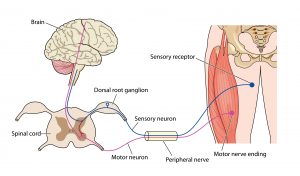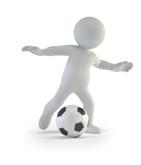The central nervous system (i.e. brain and spinal cord) consists of the sensory system and the motor system:
- Sensory receptors in our muscles, joints and skin receive information about what state of contraction a muscle is in, what position our joints are in and what sensations we are feeling. This information is constantly sent to the brain by sensory nerves (neurons). The brain interprets and co-ordinates all the incoming information.
- The motor system then sends a response back via the motor nerves (neurons) telling the muscles how to contract individually and in relation to other muscles.
Co-ordination of motor and sensory information is required to produce accurate movement. Complex movements require a higher degree of co-ordination than simple movements. The activity of muscles is co-ordinated by the central nervous system so that muscles work together to produce desired positions and movement:
- Muscles are told when to contract, lengthen or stay fixed in
 relation to other muscles so that they do their job at the right time.
relation to other muscles so that they do their job at the right time. - Muscles are told by how much they should shorten, lengthen or stay fixed to produce the correct distance of movement.
- Muscles are told how fast or slow to contact to produce the correct speed of movement.
Messages are relayed between the central nervous system and muscles via the peripheral nervous system.